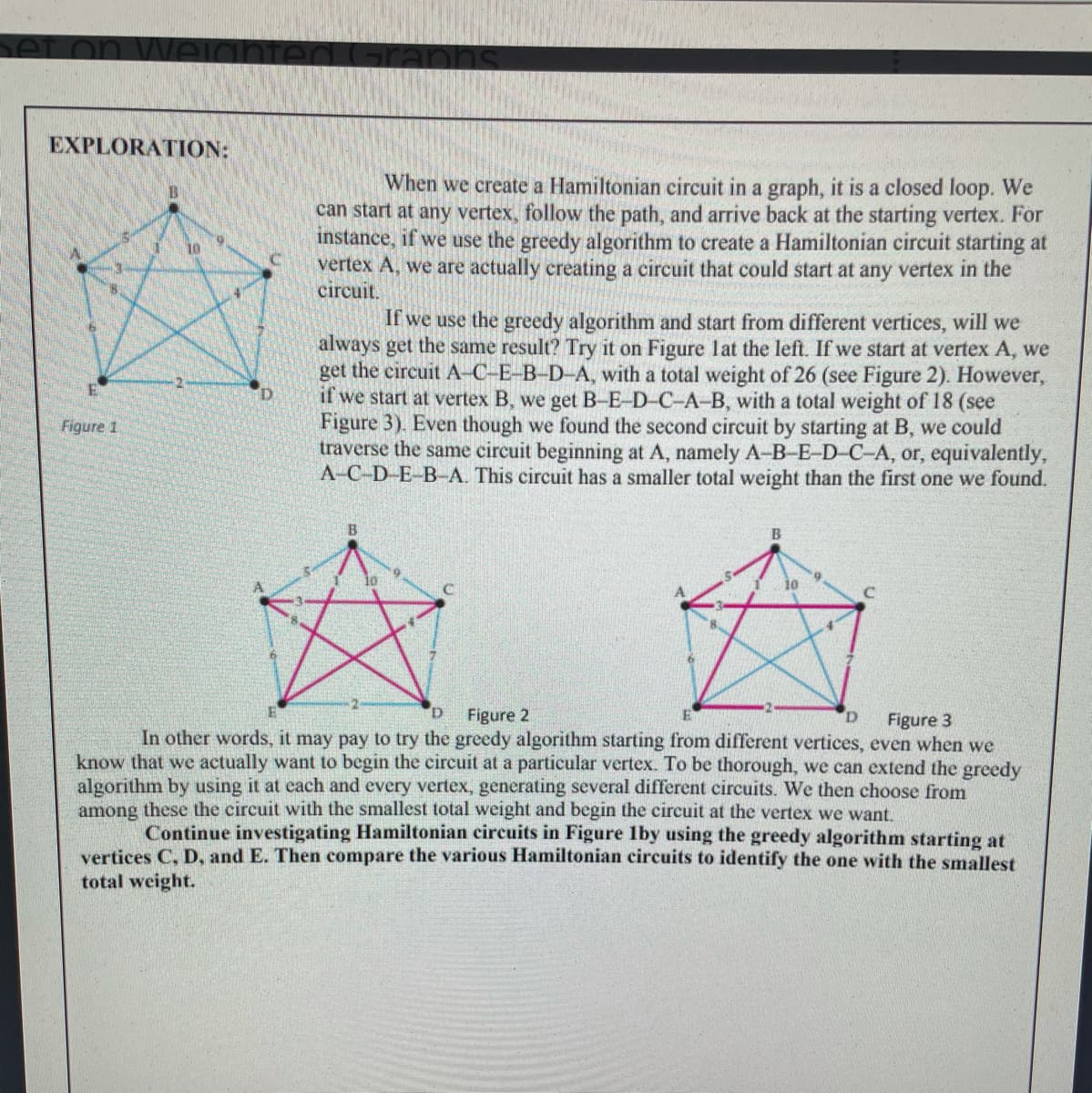When we create a Hamiltonian circuit in a graph, it is a closed loop. We can start at any vertex, follow the path, and arrive back at the starting vertex. For instance, if we use the greedy algorithm to create a Hamiltonian circuit starting at vertex A, we are actually creating a circuit that could start at any vertex in the circuit. If we use the greedy algorithm and start from different vertices, will we always get the same result? Try it on Figure lat the left. If we start at vertex A, we get the circuit A-C-E-B-D-A, with a total weight of 26 (see Figure 2). However, if we start at vertex B, we get B-E-D-C-A-B, with a total weight of 18 (see Figure 3). Even though we found the second circuit by starting at B, we could traverse the same circuit beginning at A, namely A-B-E-D-C-A, or, equivalently, A-C-D-E-B-A. This circuit has a smaller total weight than the first one we found. D. gure 1
When we create a Hamiltonian circuit in a graph, it is a closed loop. We can start at any vertex, follow the path, and arrive back at the starting vertex. For instance, if we use the greedy algorithm to create a Hamiltonian circuit starting at vertex A, we are actually creating a circuit that could start at any vertex in the circuit. If we use the greedy algorithm and start from different vertices, will we always get the same result? Try it on Figure lat the left. If we start at vertex A, we get the circuit A-C-E-B-D-A, with a total weight of 26 (see Figure 2). However, if we start at vertex B, we get B-E-D-C-A-B, with a total weight of 18 (see Figure 3). Even though we found the second circuit by starting at B, we could traverse the same circuit beginning at A, namely A-B-E-D-C-A, or, equivalently, A-C-D-E-B-A. This circuit has a smaller total weight than the first one we found. D. gure 1
Advanced Engineering Mathematics
10th Edition
ISBN:9780470458365
Author:Erwin Kreyszig
Publisher:Erwin Kreyszig
Chapter2: Second-order Linear Odes
Section: Chapter Questions
Problem 1RQ
Related questions
Question

Transcribed Image Text:EXPLORATION:
When we create a Hamiltonian circuit in a graph, it is a closed loop. We
can start at any vertex, follow the path, and arrive back at the starting vertex. For
instance, if we use the greedy algorithm to create a Hamiltonian circuit starting at
vertex A, we are actually creating a circuit that could start at any vertex in the
circuit.
10
If we use the greedy algorithm and start from different vertices, will we
always get the same result? Try it on Figure lat the left. If we start at vertex A, we
get the circuit A-C-E-B-D-A, with a total weight of 26 (see Figure 2). However,
if we start at vertex B, we get B-E-D-C-A-B, with a total weight of 18 (see
Figure 3). Even though we found the second circuit by starting at B, we could
traverse the same circuit beginning at A, namely A-B-E-D-C-A, or, equivalently,
A-C-D-E-B-A. This circuit has a smaller total weight than the first one we found.
Figure 1
B.
10
C.
Figure 2
Figure 3
In other words, it may pay to try the greedy algorithm starting from different vertices, even when we
know that we actually want to begin the circuit at a particular vertex. To be thorough, we can extend the greedy
algorithm by using it at each and every vertex, generating several different circuits. We then choose from
among these the circuit with the smallest total weight and begin the circuit at the vertex we want.
Continue investigating Hamiltonian circuits in Figure lby using the greedy algorithm starting at
vertices C, D, and E. Then compare the various Hamiltonian circuits to identify the one with the smallest
total weight.
Expert Solution
This question has been solved!
Explore an expertly crafted, step-by-step solution for a thorough understanding of key concepts.
This is a popular solution!
Trending now
This is a popular solution!
Step by step
Solved in 3 steps

Knowledge Booster
Learn more about
Need a deep-dive on the concept behind this application? Look no further. Learn more about this topic, advanced-math and related others by exploring similar questions and additional content below.Recommended textbooks for you

Advanced Engineering Mathematics
Advanced Math
ISBN:
9780470458365
Author:
Erwin Kreyszig
Publisher:
Wiley, John & Sons, Incorporated

Numerical Methods for Engineers
Advanced Math
ISBN:
9780073397924
Author:
Steven C. Chapra Dr., Raymond P. Canale
Publisher:
McGraw-Hill Education

Introductory Mathematics for Engineering Applicat…
Advanced Math
ISBN:
9781118141809
Author:
Nathan Klingbeil
Publisher:
WILEY

Advanced Engineering Mathematics
Advanced Math
ISBN:
9780470458365
Author:
Erwin Kreyszig
Publisher:
Wiley, John & Sons, Incorporated

Numerical Methods for Engineers
Advanced Math
ISBN:
9780073397924
Author:
Steven C. Chapra Dr., Raymond P. Canale
Publisher:
McGraw-Hill Education

Introductory Mathematics for Engineering Applicat…
Advanced Math
ISBN:
9781118141809
Author:
Nathan Klingbeil
Publisher:
WILEY

Mathematics For Machine Technology
Advanced Math
ISBN:
9781337798310
Author:
Peterson, John.
Publisher:
Cengage Learning,

